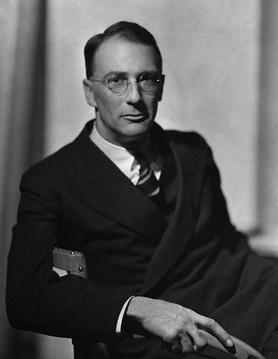
Cecil Louis Troughton Smith, known by his pen name Cecil Scott "C. S." Forester, was an English novelist known for writing tales of naval warfare, such as the 12-book Horatio Hornblower series depicting a Royal Navy officer during the Napoleonic Wars.
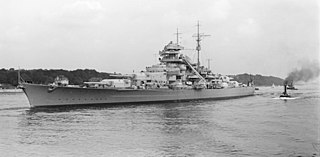
Bismarck was the first of two Bismarck-class battleships built for Nazi Germany's Kriegsmarine. Named after Chancellor Otto von Bismarck, the ship was laid down at the Blohm & Voss shipyard in Hamburg in July 1936 and launched in February 1939. Work was completed in August 1940, when she was commissioned into the German fleet. Bismarck and her sister ship Tirpitz were the largest battleships ever built by Germany, and two of the largest built by any European power.

Force H was a British naval formation during the Second World War. It was formed in late-June 1940, to replace French naval power in the western Mediterranean removed by the French armistice with Nazi Germany. The force occupied an odd place within the naval chain of command. Normal British practice was to have naval stations and fleets around the world, whose commanders reported to the First Sea Lord via a flag officer. Force H was based at Gibraltar but there was already a flag officer at the base, Flag Officer Commanding, North Atlantic. The commanding officer of Force H did not report to this Flag Officer but directly to the First Sea Lord, Admiral of the Fleet Sir Dudley Pound.
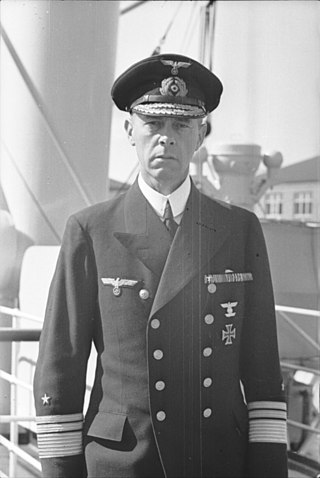
Operation Rheinübung was the last sortie into the Atlantic by the new German battleship Bismarck and heavy cruiser Prinz Eugen on 18–27 May 1941, during World War II. This operation aimed to block Allied shipping to the United Kingdom as the previously successful Operation Berlin had done. After Bismarck had sunk HMS Hood during the Battle of the Denmark Strait, it culminated with the sinking of the Bismarck, while Prinz Eugen escaped to port in occupied France. From that point on, Germans would rely only on U-boats to wage the Battle of the Atlantic.

Otto Ernst Lindemann was a German Kapitän zur See. He was the only commander of the battleship Bismarck during its eight months of service in World War II.

The King George V-class battleships were the most modern British battleships in commission during the Second World War. Five ships of this class were built: HMS King George V, HMS Prince of Wales (1941), HMS Duke of York (1941), HMS Anson (1942) and HMS Howe (1942). The names honoured King George V, and his sons, Edward VIII, who had been Prince of Wales, and George VI who was Duke of York before ascending to the throne; the final two ships of the class were named after prominent 18th century admirals of the Royal Navy.

HMS Prince of Wales was a King George V-class battleship of the Royal Navy that was built at the Cammell Laird shipyard in Birkenhead. Despite being sunk less than a year after she was commissioned, Prince of Wales had an extensive battle history, first seeing action in August 1940 while still being outfitted in her drydock, when she was attacked and damaged by German aircraft. In her brief career, she was involved in several key actions of the Second World War, including the May 1941 Battle of the Denmark Strait where she scored three hits on the German battleship Bismarck, forcing Bismarck to abandon her raiding mission and head to port for repairs. Prince of Wales later escorted one of the Malta convoys in the Mediterranean, during which she was attacked by Italian aircraft. In her final action, she attempted to intercept Japanese troop convoys off the coast of Malaya as part of Force Z when she was sunk by Japanese aircraft on 10 December 1941, two days after the attack on Pearl Harbor.

The Battle of the Denmark Strait was a naval engagement in the Second World War, which took place on 24 May 1941 between ships of the Royal Navy and the Kriegsmarine. The British battleship HMS Prince of Wales and the battlecruiser HMS Hood fought the German battleship Bismarck and the heavy cruiser Prinz Eugen, which were attempting to break out into the North Atlantic to attack Allied merchant shipping through the Denmark Strait between Greenland and Iceland.

Sink the Bismarck! is a 1960 black-and-white CinemaScope British war film based on the 1959 book The Last Nine Days of the Bismarck by C. S. Forester. It stars Kenneth More and Dana Wynter and was directed by Lewis Gilbert. To date, it is the only film made that deals directly with the operations, chase and sinking of the battleship Bismarck by the Royal Navy during the Second World War. Although war films were common in the 1960s, Sink the Bismarck! was seen as something of an anomaly, with much of its time devoted to the "unsung back-room planners as much as on the combatants themselves". Its historical accuracy, in particular, met with much praise despite a number of inconsistencies.
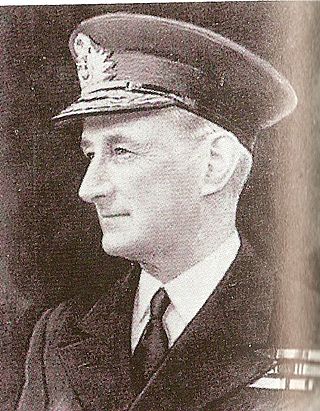
Vice-Admiral Lancelot Ernest Holland, was a Royal Navy officer who commanded the British force in the Battle of the Denmark Strait in May 1941 against the German battleship Bismarck. Holland was lost when he stayed at his post during the sinking of HMS Hood.

"Sink the Bismark" is a march song by American country music singer Johnny Horton and songwriter Tillman Franks, based on the pursuit and eventual sinking of the German battleship Bismarck in May 1941, during World War II. Horton released this song through Columbia Records in 1960, when it reached #3 on the charts. As originally released, the record label used the common misspelling "Bismark"; this error was corrected for later releases of the song. It was inspired by the 1960 British war movie Sink the Bismarck! and was, with the producer John Brabourne's approval, commissioned from Johnny Horton by 20th Century Fox who were worried about the subject's relative obscurity in the United States. Inexplicably, the size comparisons of guns and shells are switched. While the song was used in U.S. theater trailers for the film, it was not used in the actual film.
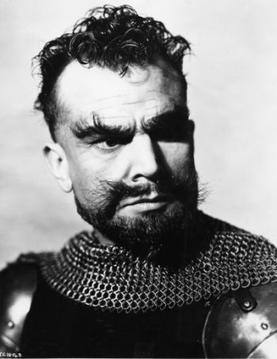
Esmond Penington Knight was an English actor. He had a successful stage and film career before World War II. For much of his later career Knight was half-blind. He had been badly wounded in 1941 while on active service on board HMS Prince of Wales when she fought the Bismarck at the Battle of the Denmark Strait, and remained totally blind for two years, though he later regained some sight in his right eye.
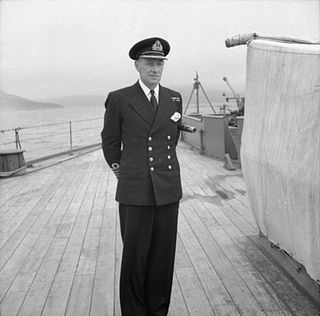
Captain John Catterall Leach, was a British naval officer. He was the only captain of the battleship HMS Prince of Wales during its short period in service.
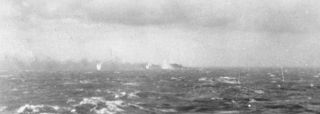
The last battle of the German battleship Bismarck took place in the Atlantic Ocean approximately 300 nautical miles west of Brest, France, on 26–27 May 1941 between the German battleship Bismarck and naval and air elements of the British Royal Navy. Although it was a decisive action between capital ships, it has no generally accepted name. It was the culmination of Operation Rheinübung where the attempt of two German ships to disrupt the Atlantic Convoys to the United Kingdom failed with the scuttling of the Bismarck.

World War II saw the end of the battleship as the dominant force in the world's navies. At the outbreak of the war, large fleets of battleships—many inherited from the dreadnought era decades before—were one of the decisive forces in naval thinking. By the end of the war, battleship construction was all but halted, and almost every remaining battleship was retired or scrapped within a few years of its end.
818 Naval Air Squadron was a Royal Navy Fleet Air Arm carrier-based squadron formed in August 1939. It served on a number of the Navy's aircraft carriers during the Second World War, serving in most of the theatres of the war, before decommissioning at the end of the war.

The Last Nine Days of the Bismarck, also published as Hunting the Bismark is a 1959 novel by C.S. Forester (1899–1966), the author of the popular Horatio Hornblower series of naval-themed books. Closely based on the actual Battle of the Bismarck Sea, the novel includes fictionalized dialogue and incidents.
Leonard B. "Tuck" Smith was an American pilot who spotted the German battleship Bismarck prior to its being sunk by British naval and air forces. Smith was the first American to participate in a World War II naval victory and is sometimes considered the first American to be directly involved in World War II for his actions.
Bismarck most often refers to:

Johann Günther Lütjens was a German admiral whose military service spanned more than 30 years and two world wars. Lütjens is best known for his actions during World War II and his command of the battleship Bismarck during her foray into the Atlantic Ocean in 1941. He was killed in action during the last battle of the battleship Bismarck.
















